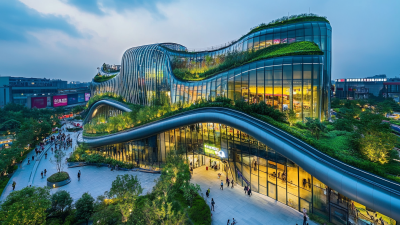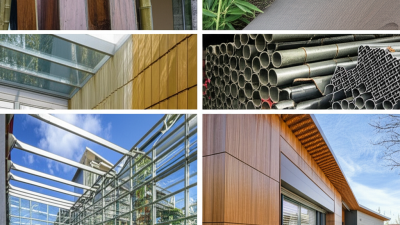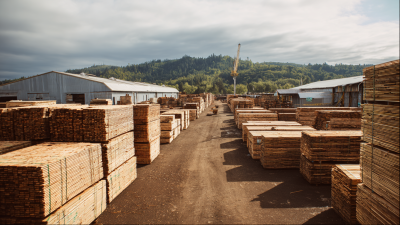Natural beauty for your favorite space
Transform Your Home: Innovative Eco-Friendly Building Materials Revolutionizing Sustainable Living
In recent years, the construction industry has witnessed a significant shift towards sustainable practices, primarily driven by the urgent need to address climate change and reduce environmental footprints. A report by the Global Alliance for Green Buildings estimates that the use of eco-friendly building materials for houses can lead to a reduction of up to 30% in greenhouse gas emissions, making them an essential component of sustainable living. Innovations in materials such as recycled steel, bamboo, and hempcrete not only promote sustainability but also enhance the energy efficiency of homes, resulting in lower utility bills and improved indoor air quality.

Moreover, the market for green building materials is projected to reach $1 trillion by 2027, underscoring a growing consumer demand for eco-friendly solutions. As homeowners increasingly seek to transform their living spaces with eco-conscious choices, incorporating eco-friendly building materials for houses is not just a trend but a vital step toward a more sustainable future.
Exploring the Benefits of Eco-Friendly Building Materials for Sustainable Homes
The rise of eco-friendly building materials is transforming the construction landscape, offering sustainable options that significantly reduce environmental impact. One major benefit of using these materials is their contribution to energy efficiency. Products like recycled steel, bamboo, and reclaimed wood not only minimize waste but also enhance insulation, leading to lower energy consumption and reduced utility bills for homeowners. By choosing these materials, homeowners can help minimize their carbon footprint while enjoying the comfort of a sustainable living space.
Additionally, eco-friendly building materials often promote healthier indoor environments. Traditional construction materials may release harmful chemicals and volatile organic compounds (VOCs), detrimental to both human health and the environment. In contrast, many sustainable options, including low-VOC paints and natural insulation made from renewable resources, ensure improved air quality and a safer home. As awareness of these benefits grows, more people are opting for green building solutions, paving the way toward a more sustainable future in home construction.

Innovative Materials: Bamboo, Recycled Steel, and Rammed Earth in Modern Construction
In recent years, the construction industry has seen a significant shift towards sustainable practices, with materials like bamboo, recycled steel, and rammed earth gaining prominence for their eco-friendly qualities. According to the World Green Building Council, buildings are responsible for 39% of global carbon emissions, emphasizing the urgent need for innovative solutions. Bamboo, known for its rapid growth and high strength-to-weight ratio, can reduce carbon footprints significantly. The International Network for Bamboo and Rattan reports that bamboo can sequester up to 50 tons of CO2 per hectare annually, making it a compelling choice for environmentally-conscious builders.
Recycled steel is another material revolutionizing modern construction. According to the Steel Recycling Institute, recycling one ton of steel saves 2,500 pounds of iron ore, 1,400 pounds of coal, and 120 pounds of limestone. This practice not only conserves natural resources but also reduces the energy consumption involved in producing new steel by up to 75%. Furthermore, rammed earth, a traditional technique gaining new traction, utilizes local soil to create sturdy, naturally insulated structures, resulting in reduced energy use during heating and cooling. With these innovative materials, the construction industry is paving the way for a more sustainable future, addressing the urgent climate change challenges we face today.

How to Choose the Right Eco-Friendly Options for Your Home Renovation Projects
When embarking on a home renovation project, selecting the right eco-friendly building materials is crucial for promoting sustainability while enhancing the aesthetic appeal of your space. According to a recent report by the World Green Building Council, buildings contribute approximately 39% of global carbon emissions, with operational energy use accounting for 28%. By choosing sustainable options, homeowners can significantly reduce their carbon footprints. Materials like bamboo, reclaimed wood, and recycled metal not only minimize environmental impact but also tend to have a lower embedded energy than traditional options.
To make informed choices, homeowners should consider certifications such as the Forest Stewardship Council (FSC) for wood products, which ensures responsible management of forests. Additionally, products labeled with Energy Star have been proven to be more energy-efficient, potentially saving consumers up to $750 annually on utility bills. Furthermore, using low-VOC (volatile organic compounds) paints and finishes can improve indoor air quality, a benefit underscored by the EPA, which states that indoor air pollution can be two to five times higher than outdoor levels. Emphasizing these eco-friendly materials in renovation projects not only supports sustainable living but also fosters a healthier home environment.
Transformative Techniques: Incorporating Natural Insulation and Green Roofs in Design
Incorporating natural insulation into home design is a transformative technique that significantly enhances energy efficiency and environmental sustainability. Materials such as wool, hemp, and cellulose provide outstanding thermal performance while reducing reliance on synthetic alternatives. These natural insulators are not only biodegradable but also help regulate indoor humidity, creating a healthier living environment. By utilizing these eco-friendly materials, homeowners can decrease their carbon footprint and promote a more sustainable lifestyle.
Similarly, green roofs are gaining traction as an innovative approach to sustainable architecture. By covering rooftops with vegetation, homeowners can improve insulation, reduce runoff, and contribute to urban biodiversity. Green roofs offer aesthetic benefits and serve as natural thermal barriers, keeping homes cooler in the summer and warmer in the winter. Additionally, they help mitigate the urban heat island effect, making cities more livable. By integrating these techniques into home designs, we can pave the way for a more sustainable future, combining functionality with eco-consciousness.
DIY Guide: Creating a Sustainable Living Space with Reclaimed and Upcycled Materials
Creating a sustainable living space has never been more accessible, especially with the increasing availability of reclaimed and upcycled materials. These materials not only reduce waste but also add character and uniqueness to your home. Start by exploring local salvage yards for wooden beams, doors, or even flooring that can be transformed into functional pieces. For instance, old pallets can be repurposed into rustic furniture, while reclaimed bricks make for stunning accent walls or fire pits.
Incorporating upcycled materials into your DIY projects encourages creativity and resourcefulness. You might consider using glass jars as charming storage solutions or transforming vintage fabric into cozy throw pillows. Additionally, items such as wine bottles can be fashioned into decorative lighting fixtures or garden borders. By prioritizing these innovative materials, you not only create a more sustainable home but also foster a deeper connection to the environment and its resources.
Embrace the journey of sustainable living by turning waste into treasures, making your home a true reflection of your eco-conscious values.
Related Posts
-

Advantages of Choosing Eco Building Products for Sustainable Construction Solutions
-

Advantages of Choosing Sustainable Construction Materials for Global Buyers
-

Top 10 Eco-Friendly Building Materials Manufacturers from China at the 137th Canton Fair
-

Revolutionizing Construction: The Ultimate Guide to Eco Friendly Building Materials for a Sustainable Future
-

Exploring Unique Features and Applications of Top Sustainable Building Materials for Modern Homes
-

How to Choose Eco Building Products for Sustainable Construction
